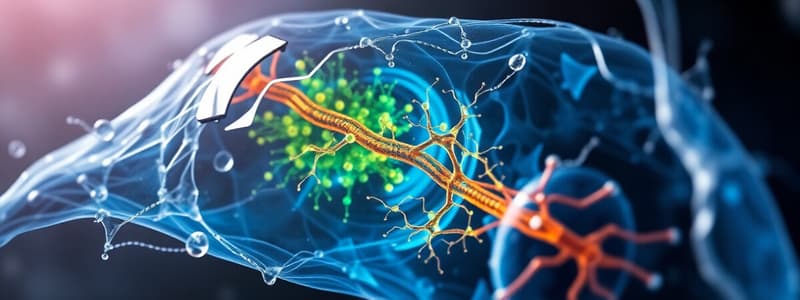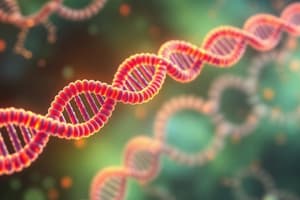Podcast
Questions and Answers
What type of modifications can affect nuclear transport efficiency?
What type of modifications can affect nuclear transport efficiency?
- Methylations
- Glycosylations
- Phosphorylations (correct)
- Acetylations
Defects in nuclear transport can only affect the transport of proteins and not RNA.
Defects in nuclear transport can only affect the transport of proteins and not RNA.
False (B)
What can the mutation of transport proteins disrupt?
What can the mutation of transport proteins disrupt?
Gene expression
The cell controls nuclear transport through various cellular signal __________ pathways.
The cell controls nuclear transport through various cellular signal __________ pathways.
Match the consequences of nuclear transport defects with their descriptions:
Match the consequences of nuclear transport defects with their descriptions:
What is the main function of nucleocytoplasmic transport?
What is the main function of nucleocytoplasmic transport?
Only small molecules can diffuse through the nuclear pore complexes.
Only small molecules can diffuse through the nuclear pore complexes.
Name the two primary proteins involved in nucleocytoplasmic transport.
Name the two primary proteins involved in nucleocytoplasmic transport.
The presence of specific _____ signals on cargo molecules determines their direction during transport.
The presence of specific _____ signals on cargo molecules determines their direction during transport.
Match the transport proteins to their respective functions:
Match the transport proteins to their respective functions:
What role does Ran-GTPase play in nucleocytoplasmic transport?
What role does Ran-GTPase play in nucleocytoplasmic transport?
Nuclear pore complexes are random structures that allow free passage of all molecules.
Nuclear pore complexes are random structures that allow free passage of all molecules.
What is the function of nuclear localization signals (NLS)?
What is the function of nuclear localization signals (NLS)?
Flashcards
Nucleocytoplasmic transport
Nucleocytoplasmic transport
The regulated process of moving molecules between the nucleus and cytoplasm.
Post-translational modifications
Post-translational modifications
Chemical changes to proteins after they are made, affecting their function.
Regulation in transport
Regulation in transport
The control mechanism ensuring selective entry and exit of molecules in the nucleus.
Consequences of transport defects
Consequences of transport defects
Signup and view all the flashcards
Impact of mutations on transport
Impact of mutations on transport
Signup and view all the flashcards
Nuclear Pore Complexes (NPCs)
Nuclear Pore Complexes (NPCs)
Signup and view all the flashcards
Active Transport
Active Transport
Signup and view all the flashcards
Importins
Importins
Signup and view all the flashcards
Exportins
Exportins
Signup and view all the flashcards
Ran-GTPase
Ran-GTPase
Signup and view all the flashcards
Nuclear Localization Signals (NLS)
Nuclear Localization Signals (NLS)
Signup and view all the flashcards
Nuclear Export Signals (NES)
Nuclear Export Signals (NES)
Signup and view all the flashcards
Study Notes
Nucleocytoplasmic Transport
- Nucleocytoplasmic transport is the continuous bidirectional movement of molecules between the nucleus and cytoplasm.
- This process is crucial for gene expression, DNA replication, and repair. Crucially, the nucleus houses the cell's genetic material, while the cytoplasm contains the machinery for protein synthesis and other cellular functions.
- The transport is not random; it is actively regulated. Specialized transport pathways across the nuclear envelope, a double membrane structure, are required to ensure the correct molecules cross at the correct times.
Nuclear Pore Complexes (NPCs)
- NPCs are large protein complexes that span the nuclear envelope.
- They act as selective gateways for the passage of molecules between the nucleus and cytoplasm.
- Different sized molecules enter and leave the nucleus via distinct pathways. Large molecules, such as proteins and RNA, require active transport, but small molecules can diffuse through these channels.
- NPCs contain numerous transport factors that facilitate the selective recognition and translocation of molecules across the nuclear membrane.
- These proteins form a central channel that molecules can travel through.
Transport Mechanisms
- Importins and exportins are crucial proteins involved in active transport.
- Importins bind to cargo molecules containing specific nuclear localization signals (NLS). These signals act like addresses, directing importins to take proteins into the nucleus.
- Exportins function similarly, but in the opposite direction, targeting cargo with nuclear export signals (NES) out of the nucleus.
- Both importins and exportins interact with motor proteins, like kinesin and dynein, to facilitate their directed movement along cytoskeletal filaments, often microtubules, in the cytoplasm and within the nuclear space to ensure targeted transport.
- Ran-GTPase plays a vital role in regulating the importin/exportin cycle, acting as a molecular switch that either shuttles proteins in or out of the nucleus.
- Ran-GTP is predominantly located in the nucleus, whereas Ran-GDP is more prevalent in the cytoplasm.
- The Ran system acts as an energy-driven molecular mechanism to maintain the necessary directional concentration gradient to power the nuclear transport cycle.
Regulation of Transport
- The presence of specific signals (NLS and NES) on cargo molecules determines their direction and entry point.
- The process is tightly regulated to maintain the integrity of the nucleus and prevent the aberrant transport of molecules, allowing for precise and selective nuclear entry and exit of molecules.
- Regulation also involves post-translational modifications of proteins, including phosphorylations, that can affect binding affinities and consequently transport efficiency.
- The cell controls transport through various cellular signal transduction pathways that can direct nuclear import or export activities in response to changes in the intracellular environment.
Consequences of Defects in Nucleocytoplasmic Transport
- Defects in nuclear transport can lead to a variety of diseases.
- Mutations in transport proteins can prevent vital proteins from reaching their nuclear destinations, disrupting gene expression and impacting cellular function, which can cause various diseases.
- This can disrupt essential cellular processes, such as protein synthesis, DNA replication, and RNA processing.
Studying That Suits You
Use AI to generate personalized quizzes and flashcards to suit your learning preferences.



